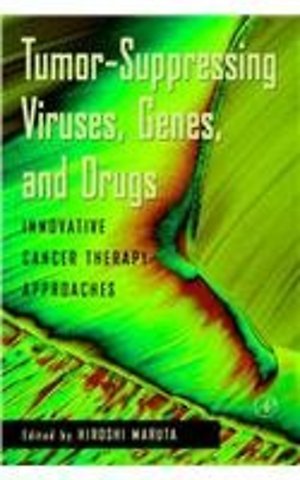<br>Contributors</br><br>Preface</br><br>1 Oncolytic Viruses: Virotherapy for Cancer</br><br> I. Introduction</br><br> II. Attributes of Replication-Selective Viruses for Cancer Treatment</br><br> III. Approaches to Optimizing Tumor-Selective Viral Replication</br><br> IV. Adenoviruses</br><br> V. Poliovirus</br><br> VI. Vesicular Stomatitis Virus</br><br> VII. Reovirus</br><br> VIII. Bacteria</br><br> IX. Vaccinia Virus</br><br> X. Herpesvirus</br><br> XI. Clinical Trial Results with Replication-Competent Adenoviruses in Cancer Patients</br><br> XII. Results from Clinical Trials with dl1520 (Onyx-015, or CI-1042)</br><br> XIII. Future Directions: Approaches to Improving the Efficacy of Replication-Selective Viral Agents</br><br> XIV. Summary</br><br> References</br><br>2 Reovirus Therapy of Ras-Associated Cancers</br><br> I. Introduction</br><br> II. Reovirus Oncolysis</br><br> III. Concluding Remarks</br><br> References</br><br>3 Oncolytic Herpes Simplex Virus (G207) Therapy: From Basic to Clinical</br><br> I. Introduction</br><br> II. Preclinical Studies of G207</br><br> III. G207 Clinical Trial</br><br> IV. Conclusions</br><br> References</br><br>4 p53 and Its Targets</br><br> I. Introduction</br><br> II. Activation of p53</br><br> III. Downstream Mediators of p53</br><br> References</br><br>5 Prospects for Tumor Suppressor Gene Therapy: RB as an Example</br><br> I. Introduction</br><br> II. Functions of RB</br><br> III. Successes with RB Gene Therapy </br><br> IV. Perspectives</br><br> References</br><br>6 CDK Inhibitors: Genes and Drugs</br><br> I. Introduction</br><br> II. G1 Regulation </br><br> III. p16INK4a and the Rb Pathway</br><br> IV. p19ARF and p53 Pathway</br><br> V. p27 and Human Cancer</br><br> VI. Conclusions and Future Perspectives</br><br> References</br><br>7 CDK Inhibitors: Small Molecular Weight Compounds</br><br> I. Introduction</br><br> II. Cyclin-Dependent Kinases, the Cell Cycle, and Cancer</br><br> III. Cyclin-Dependent Kinase Inhibitors, a Large Variety of Structures</br><br> IV. Cyclin-Dependent Kinase Inhibitors, All Competing with ATP</br><br> V. Cyclin-Dependent Kinase Inhibitors, the Selectivity Problem</br><br> VI. Cyclin-Dependent Kinase Inhibitors, Cellular Effects</br><br> VII. Cyclin-Dependent Kinase Inhibitors, Antitumor Activity</br><br> VIII. Conclusion</br><br> References</br><br>8 NF1 and Other RAS-Binding Peptides</br><br> I. RAS Molecules: Normal versus Oncogenic Mutants </br><br> II. Super GAP?</br><br> III. RAS-Binding Fragment of NF1</br><br> IV. c-RAF-1</br><br> V. PI-3 Kinase</br><br> VI. Ral GDS </br><br> References</br><br>9 Cytoskeletal Tumor Suppressor Genes</br><br> I. Introduction (Historical Background)</br><br> II. Type I Cytoskeletal Tumor Suppressors</br><br> III. Type II Cytoskeletal Tumor Suppressors</br><br> References</br><br>10 TGF-? Signaling and Carcinogenesis</br><br> I. Introduction</br><br> II. Dual Role of TGF-? in Carcinogenesis</br><br> III. TGF-? Superfamily Signaling</br><br> IV. Perturbation of TGF-? Signaling in Cancer Cells</br><br> V. Perspectives</br><br> References</br><br>11 DAN Gene</br><br> I. Introduction</br><br> II. Cloning of DAN cDNA</br><br> III. Transfection of DAN</br><br> IV. Role of DAN in Neuroblastomas</br><br> V. Structural Features of the DAN Protein</br><br> VI. Genomic Structure of DAN</br><br> VII. DAN Family</br><br> References</br><br>12 Design of Hammerhead Ribozymes and Allosterically Controllable Maxizymes for Cancer Gene Therapy</br><br> I. Introduction</br><br> II. Ribozyme Expression System in Cells</br><br> III. Design of the tRNAVal-Driven Ribozyme That Is Transcribed by pol III</br><br> IV. Design of Allosterically Controlled Maxizymes</br><br> V. Conclusion</br><br> References</br><br>13 Inhibitors of Angiogenesis</br><br> I. Introduction—Angiogenesis</br><br> II. Angiogenesis Inhibitors</br><br> III. Future Directions</br><br> References</br><br>14 Geranylgeranylated RhoB Mediates the Apoptotic and Antineoplastic Effects of Farnesyltransferase Inhibitors: New Insights into Cancer Cell Suicide</br><br> I. Introduction </br><br> II. Do Farnesyltransferase Inhibitors Target a Unique Aspect of Neoplastic Pathophysiology?</br><br> III. Ras Is Not a Crucial Target of Farnesyltransferase Inhibitors</br><br> IV. RhoB Is a Crucial Target of Farnesyltransferase Inhibitors</br><br> V. Farnesyltransferase Inhibitors Act through a Gain of Function Mechanism Involving RhoB-GG</br><br> VI. RhoB-GG Is Required to Mediate Apoptosis by Farnesyltransferase Inhibitors</br><br> VII. RhoB-GG and the Antiangiogenic Properties of Farnesyltransferase Inhibitors</br><br> VIII. Clinical Implications</br><br> IX. Summary</br><br> References</br><br>15 RAS Binding Compounds</br><br> I. Introduction</br><br> II. Ras Cycle and Ras–Raf Signaling Pathway</br><br> III. The Structure of Ras Proteins</br><br> IV. Drug Target Sites of Ras</br><br> V. Conclusions and Outlook</br><br> References</br><br>16 Actin-Binding Drugs: MKT-077 and Chaetoglobosin K (CK)</br><br> I. Introduction</br><br> II. MKT-077: F-Actin Bundler</br><br> III. Chaetoglobosin K: F-Actin Capper</br><br> References</br><br>17 Tyr Kinase Inhibitors as Potential Anticancer Agents: EGF Receptor and ABL Kinases</br><br> I. Introduction</br><br> II. Tyr Kinase Inhibitors</br><br> III. Chronic Myelogenous Leukemia</br><br> IV. Epidermal Growth Factor Receptor</br><br> V. Antagonists of the Epidermal Growth Factor Receptor Extracellular Domain</br><br> VI. Chemical Inhibitors of the Kinase Domain of the Epidermal Growth Factor Receptor</br><br> VII. Epidermal Growth Factor Receptor Antagonists or Inhibitors Act Synergistically to Kill Tumor Cells</br><br> VIII. The Effects of Abl Inhibitors on Leukemia</br><br> References</br><br>18 Antagonists of Rho Family GTPases: Blocking PAKs, ACKs, and Rock</br><br> I. Rho Family GTPases (Rho, Rac, and CDC42)</br><br> II. Blocking PAKs</br><br> III. Blocking CDC42 Pathways (ACKs and N-WASP)</br><br> IV. Blocking Rho Pathways</br><br> V. Rac-Specific Inhibitors?</br><br> References</br><br>19 Integrin Antagonists as Cancer Therapeutics</br><br> I. Introduction</br><br> II. Signaling Pathways Activated by Integrins</br><br> InII. Role of Integrins in Neoplastic Transformatio</br><br> IV. Role of Integrins in Tumor-Induced Angiogenesis</br><br> V. Integrin Antagonists as Antiangiogenesis Agents</br><br> VI. Conclusions and Future Perspectives</br><br> References</br><br>20 Functional Rescue of Mutant p53 as a Strategy to Combat Cancer</br><br> I. Introduction </br><br> II. Multiple Pathways of p53-Induced Apoptosis</br><br> III. Regulation of p53 Activity</br><br> IV. Approaches toward Reactivation of Mutant p53</br><br> V. Implications for Tumor Therapy and Future Perspectives</br><br> References</br><br>Index</br>

